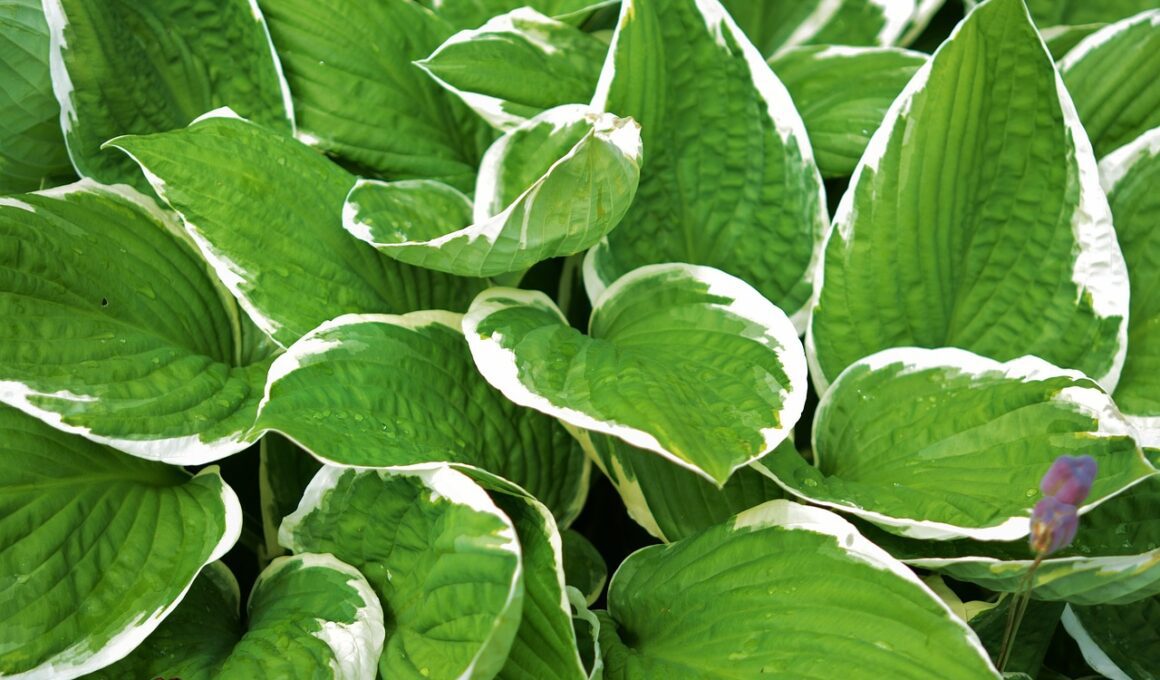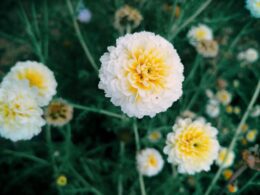Are hostas perennials?
Are you a fan of gardening and landscaping? If so, you may have come across the term ‘perennial’ before. Perennials are plants that come back year after year, as opposed to annuals which need to be replanted each year.
But what about hostas? Are they perennials?
The answer is yes! Hostas are a type of perennial plant that are prized for their lush foliage and beautiful flowers. They are a popular choice for gardeners and landscapers alike, as they are easy to care for and can thrive in a variety of conditions.
In this article, we will explore what it means for hostas to be perennials, how to care for them, and some common problems you may encounter. So whether you’re a seasoned gardener or just starting out, read on to learn more about the beauty and benefits of hostas as perennials.
Understanding the Definition of Perennials
You’ll understand what plants come back year after year with new growth, giving you a beautiful garden without having to replant each season. These are called perennials, and they have a longer lifespan than annual plants.
Annual plants only live for one season, while perennials can live for multiple years. Perennial lifespan varies depending on the plant species, but they typically have a longer lifespan than annuals. Some perennials can live for decades, while others may only live for a few years.
However, perennials have the ability to come back year after year, unlike annuals, which need to be replanted each season. It’s important to understand the difference between perennials and annuals when planning your garden.
Perennials can provide a sturdy foundation for your garden, as they will come back year after year, while annuals can add variety and color. By incorporating both types of plants, you can create a beautiful and diverse garden that will thrive for years to come.
Characteristics of Hostas
The leaves of these plants are often large and textured, making them a popular choice for shade gardens. Hostas are known for their beautiful foliage and come in a variety of colors, ranging from green to blue, yellow, and even white. They are low maintenance perennials that can last for years if taken care of properly.
There are numerous varieties available, so it’s important to choose the right one for your garden. Some hostas are better suited for full sun, while others prefer shade. Make sure to plant them in well-draining soil and water them regularly. Hostas can also benefit from fertilization during the growing season.
When planting hostas, it’s important to space them out properly to allow for growth and prevent overcrowding. They should be planted at least 18 inches apart, depending on the variety. Hostas are also susceptible to slugs and snails, so it’s important to keep an eye out for these pests and take measures to control them.
By following these planting tips and caring for your hostas properly, you can enjoy their beauty in your garden for years to come.
Can I Determine if Foxgloves are Biennial or Perennial using the Same Method as Hostas?
When it comes to distinguishing foxgloves by lifecycle, the same method as hostas may not apply. Foxgloves are commonly biennial, meaning they complete their lifecycle in two years. In contrast, hostas are perennial and can live for multiple years without the need for replanting. It is important to understand the specific characteristics and growth patterns of each plant to determine their lifecycle accurately.
Caring for Hostas as Perennials
To keep these beautiful plants thriving year after year, make sure you’re providing them with the proper care and attention they deserve. Hostas are perennials, which means they come back every year, but they still need some attention to stay healthy.
Here are three best practices to keep in mind when caring for hostas as perennials:
-
Watering: Hostas need consistent moisture, but not too much. Make sure to water them deeply once a week, especially during hot, dry weather. Avoid over-watering or letting them sit in standing water, as this can lead to root rot.
-
Seasonal maintenance: Hostas need some seasonal maintenance to stay healthy. In the spring, remove any dead leaves and debris that may have accumulated over the winter. In the summer, keep an eye out for pests like slugs and snails, which can damage the leaves. In the fall, cut back any dead foliage and mulch around the base of the plant to protect it from winter weather.
-
Fertilizing: Hostas benefit from regular fertilization, especially in the spring and early summer when they’re actively growing. Use a balanced fertilizer and follow the package instructions for application rates. Avoid over-fertilizing, as this can lead to soft, weak growth and make the plant more susceptible to pests and diseases.
By following these best practices and providing your hostas with the care and attention they need, you can enjoy their beauty year after year. Remember to water them deeply, perform seasonal maintenance, and fertilize them regularly for the healthiest plants possible.
Common Problems with Hostas
If you’re growing hostas in your garden, you should be aware of some common problems that may arise.
Pests and diseases are some of the most significant issues that you may encounter, such as slugs, snails, and fungal infections.
Additionally, environmental stressors like heat, drought, and poor soil conditions can also affect the health and growth of your hostas.
Pests and Diseases
Pests and diseases can affect your hostas, but don’t worry, with proper care, your garden can still flourish.
Managing infestations is essential to keeping your hostas healthy. Slugs and snails are common culprits that love to munch on the leaves of hostas. You can prevent these pests by removing any debris around the plants, keeping the area clean, and using a slug and snail bait.
Additionally, aphids and spider mites can also attack hostas, but using insecticidal soap can help control these pests.
Preventing fungal infections is also crucial to the health of your hostas. Fungal diseases such as powdery mildew, anthracnose, and crown rot can harm your plants. Good air circulation and proper watering can help prevent these diseases. Avoid overhead watering and water the soil directly. Remove any infected leaves immediately, and dispose of them away from the garden.
With proper care and attention, your hostas can remain healthy and beautiful additions to your garden.
Environmental Stressors
Don’t let environmental stressors hinder the beauty of your garden – learn how to protect your hostas from harsh weather conditions and other external factors.
Hostas are usually hardy and can adapt to various climates, but extreme temperatures, drought, flooding, and strong winds can still damage them. To prevent these stressors from affecting your plants, you need to understand their climate adaptation.
Hostas thrive in moist, well-drained soils with a pH level between 6.0 and 7.5. However, too much water can lead to root rot, so make sure to water your hostas only when the soil is dry to the touch.
In areas with hot summers, you can protect your hostas by providing them with some shade during the hottest hours of the day. Mulching with organic materials like leaves or wood chips can also help retain moisture and regulate soil temperature.
By managing your soil and providing your hostas with the right environment, you can ensure that they grow healthy and strong despite external stressors.
Conclusion: Enjoying the Beauty and Benefits of Hostas as Perennials
Get ready to enjoy the lasting beauty and benefits of these plants year after year. Hostas are perennials, which means they grow back each year without needing to be replanted. This makes them a great investment for your landscaping options and garden design.
Not only are hostas low maintenance, but they also provide a variety of benefits. They can help prevent soil erosion, attract pollinators, and improve air quality. Plus, with so many different varieties and colors, they can add a pop of visual interest to any outdoor space.
So go ahead and plant those hostas with confidence, knowing that they will continue to thrive and bring joy to your garden for years to come. And don’t forget to take some time to appreciate their beauty and all the benefits they provide.
Frequently Asked Questions
What are some recommended companion plants to grow alongside hostas?
If you’re looking for some great companion plants to grow alongside your hostas, there are plenty of options out there.
Shade loving blooms like astilbes and bleeding hearts are great choices, as they’ll thrive in the same environment as your hostas.
Additionally, deer resistant options like daffodils and alliums can help protect your garden from pesky critters.
By adding these plants to your garden, you’ll not only create a beautiful and diverse space, but you’ll also ensure that your hostas have the best chance to thrive.
So go ahead and get planting – your garden (and your hostas) will thank you!
Can hostas be grown in containers?
Growing hostas in containers is a fantastic idea for those with limited garden space. Hostas are great container plants as long as you use the right soil.
It’s essential to use a high-quality, well-draining potting mix with a pH between 6.0 and 7.5. You can also add compost or slow-release fertilizer for extra nutrients.
When planting hostas in containers, make sure to choose a pot that’s at least 12 inches deep and wide, with good drainage. Keep the soil moist but not waterlogged, and place the container in a spot with partial shade.
With proper care, your hostas will thrive in their container and bring beauty to your space.
How do you propagate hostas?
If you want to propagate your hostas, there are several different methods to choose from. One of the easiest and most effective ways is to divide the plants. Doing so not only increases the number of hostas you have, but it can also improve their health and appearance.
The best time to propagate hostas is in early spring or fall when the weather is mild. To do so, simply dig up the plant and gently separate the roots into two or more sections. Be sure to keep each section intact and replant them immediately.
Some common mistakes to avoid include damaging the roots, planting too deep, and not providing enough water. With a little care and attention, you can successfully propagate your hostas and enjoy their beauty for years to come.
Are all hosta varieties suitable for growing in all climates?
When choosing hosta varieties to grow in your garden, it’s important to consider their climate suitability and planting conditions. Not all hostas are suitable for all climates, so it’s important to do your research before making a purchase.
Some hostas prefer cooler temperatures and more shade, while others can tolerate more sun and heat. Additionally, planting conditions such as soil type and moisture levels can also impact the success of your hostas.
By choosing the right hosta for your specific climate and planting conditions, you can ensure a successful and thriving garden.
Do hostas attract any beneficial insects or wildlife to the garden?
Looking to attract friendly pollinators to your garden? Look no further than pollinator friendly hosta varieties!
These hostas not only add beauty to your landscape, but they also serve as a natural pest control by attracting beneficial insects like bees and butterflies.
Using hostas in natural pest control means you can avoid harmful chemicals while still protecting your plants from unwanted pests.
So add some pollinator friendly hostas to your garden and watch as the wildlife thrives!
Conclusion
So, you’ve learned that hostas are indeed perennials! This means that they’ll come back year after year, bringing their beautiful foliage and benefits to your garden.
As long as you care for them properly, hostas can thrive as perennials in your garden for many years to come. Remember to provide your hostas with plenty of shade, water, and nutrients.
Keep an eye out for common problems such as slugs and snails, and take steps to prevent and treat them. With proper care, your hostas will reward you with their stunning beauty and benefits as perennials in your garden.
Enjoy!







